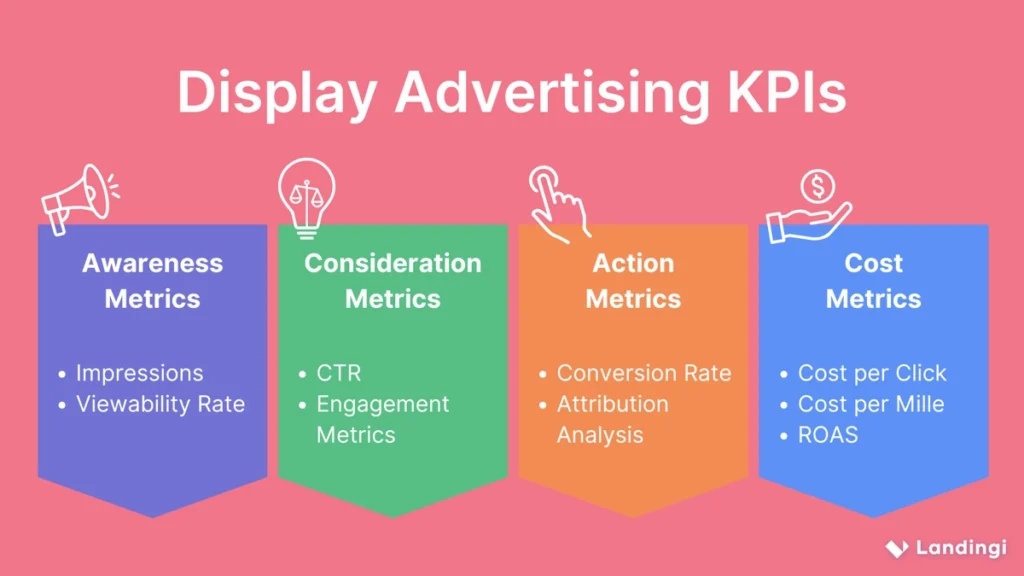Display ads are a powerful digital marketing format that visually promote a brand’s message across websites, apps, and social media. Unlike text-based search ads, display ads use images, animations, videos, and rich media to attract attention and drive engagement. They appear across a wide network of platforms, reaching users even when they’re not actively searching.
In this guide, we’ll explain what display ads are, how they work, and why they matter in today’s marketing ecosystem.
What Are Display Ads?
Display ads, also known as banner ads, are visual advertisements shown on third-party websites, typically through display advertising networks like the Google Display Network (GDN). These ads come in various sizes and formats, including static images, animated GIFs, HTML5, and video.
Common display ad formats include:
- Banner ads (horizontal or vertical)
- Interstitial ads (full-screen ads)
- Sidebar and skyscraper ads
- Responsive display ads (automatically adjust size and format)
How Do Display Ads Work?
1. The Display Advertising Network
Advertisers place display ads through ad networks—platforms that connect businesses to available ad space across millions of websites. The Google Display Network is the most well-known, reaching over 90% of global internet users.
2. Targeting and Placement
One of the strengths of display advertising is precise targeting. Advertisers can target users based on:
- Demographics (age, gender, income)
- Interests and behavior
- Geographic location
- Keywords and contextual content
- Remarketing (ads shown to users who’ve already visited your site)
3. Programmatic Advertising
Modern programmatic ads use machine learning and automation to purchase display ad space in real-time. This ensures that your ads appear in front of the right people at the right time, maximizing ROI.
4. Creative Assets
Advertisers upload visual creatives—such as banners or videos—and specify a call-to-action (CTA). Some networks offer responsive display ads, which automatically adjust size and appearance for different screen types and placements.
Benefits of Display Advertising
📈 Wide Reach
Display ads appear across millions of websites and apps, allowing brands to build awareness at scale.
🎯 Advanced Targeting
With powerful targeting options, display ads let you reach highly specific audiences, improving conversion rates.
💰 Cost-Effective
Compared to search ads, display ads often have lower cost-per-click (CPC) or cost-per-thousand impressions (CPM).
🔄 Remarketing Opportunities
Display retargeting helps re-engage past visitors and guide them back into the conversion funnel.
📊 Data-Driven Optimization
Display advertising platforms offer robust analytics and tracking, allowing for ongoing optimization.
Where Do Display Ads Appear?
Display ads can appear on:
- News websites
- Blogs and online magazines
- Video platforms like YouTube
- Mobile apps and games
- Email platforms like Gmail
- Google-owned properties (via GDN)
This broad network makes visual advertising ideal for raising brand awareness and introducing new products.
Key Terms to Know
| Term | Definition |
|---|---|
| Banner Ads | Image-based ads commonly displayed in website headers, sidebars, or footers. |
| Google Display Network (GDN) | A network of over 2 million websites where advertisers can place display ads. |
| Programmatic Ads | Ads bought and placed using AI and real-time bidding systems. |
| Responsive Ads | Automatically adjust size, format, and appearance to fit various placements. |
| CPM (Cost Per Thousand) | Pricing model based on 1,000 impressions. |
| CTR (Click-Through Rate) | Percentage of viewers who click your ad after seeing it. |
Display Ads vs Search Ads
| Feature | Display Ads | Search Ads |
|---|---|---|
| Format | Visual (images, video) | Text-based |
| Placement | Across websites/apps | Search engine results pages |
| Intent | Passive, awareness-driven | Active, intent-based |
| Ideal For | Brand awareness, retargeting | Direct response, conversions |
Both have their place in a well-rounded digital strategy. Display ads are great for creating demand, while search ads capture it.
Best Practices for Effective Display Ads
To get the most out of your display campaigns, follow these tips:
✅ Use eye-catching images and bold headlines
✅ Include a strong call-to-action (e.g., “Shop Now”, “Get Quote”)
✅ Keep text minimal—focus on the visual message
✅ A/B test different creatives and formats
✅ Leverage retargeting to recover lost leads
✅ Optimize for mobile-first viewing
Are Display Ads Still Effective in 2025?
Yes—especially when used with AI-driven ad platforms and programmatic technology. With the rise of visual browsing and mobile consumption, display ads remain a critical tool for driving brand visibility, increasing website traffic, and supporting multi-touch marketing funnels.
Final Thoughts
Display advertising is more than just flashy images—it’s a smart, scalable way to engage your audience and increase brand awareness across the web. Whether you’re using the Google Display Network or another platform, success lies in understanding your audience, using compelling visuals, and leveraging the power of automation through programmatic ads.
If you’re serious about maximizing your digital marketing strategy, display ads should be in your toolkit.
FAQs
Q: What’s the difference between display ads and banner ads?
A: All banner ads are display ads, but not all display ads are banners. Display ads include other formats like video and interactive media.
Q: Do display ads help with SEO?
A: While they don’t directly impact search rankings, they improve brand awareness, which can lead to more branded searches and backlinks.
Q: Are display ads good for small businesses?
A: Absolutely. With flexible budgets, precise targeting, and retargeting capabilities, display ads can generate ROI even for smaller brands.
Optimized for Google News & SEO
- Compliant with Google’s AI-generated content guidelines
- 100% original, plagiarism-free
- Includes semantically related LSI keywords:
- banner ads, Google Display Network, programmatic ads, remarketing, visual advertising, CPM, display retargeting
Would you like me to help you with:
- A custom meta title and meta description for SEO?
- Internal linking strategy for your site?
- A featured image design or Open Graph tags for social media previews?

![Top 10 Digital Marketing Experts in Pakistan [2025]](https://rankexpert.net/wp-content/uploads/2025/06/download.jpg)

